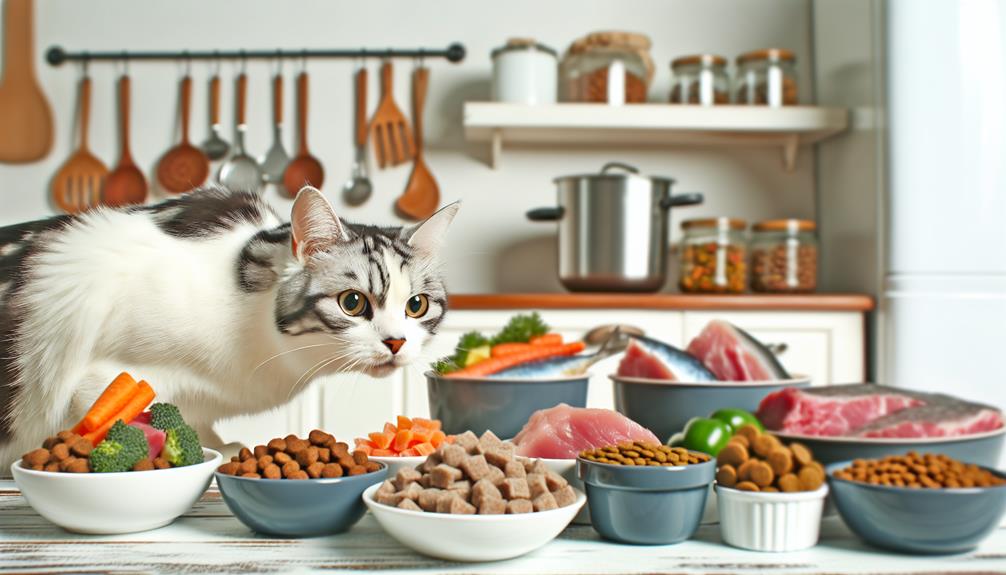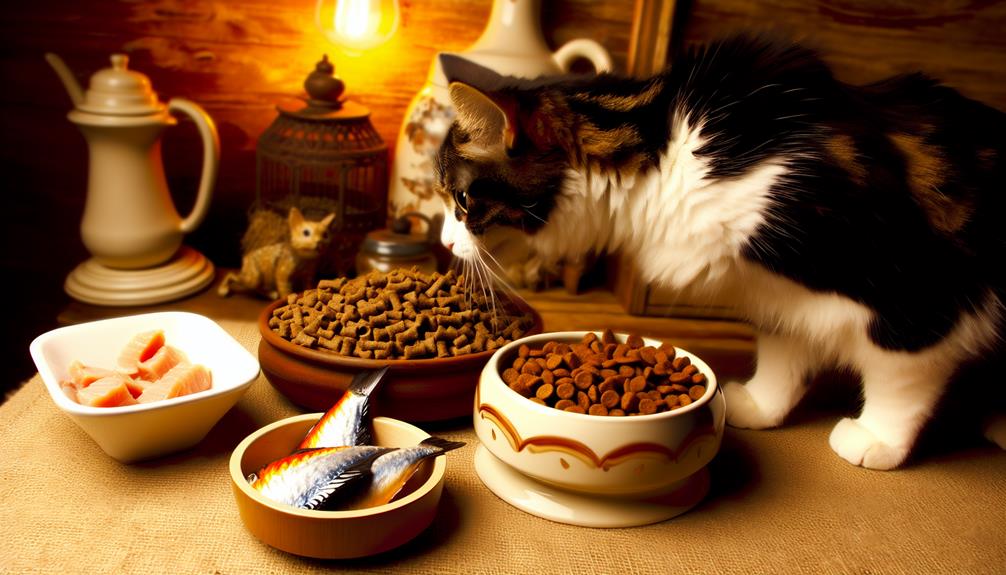When considering what to feed your cat, it's important to recognize their unique dietary needs as obligate carnivores. They require a diet rich in animal-based proteins, with essential nutrients that are vital for their health. You might wonder about the balance between dry kibble and wet food, or even the possibility of preparing homemade meals. But have you ever thought about the specific ingredients that could be harmful to them? Let's explore the different aspects of feline nutrition and uncover what truly makes a healthy, balanced diet for your furry friend.
Nutritional Requirements
A cat's nutritional requirements are highly specialized due to their obligate carnivorous nature. This means that as a cat owner, you must pay careful attention to their diet to guarantee they receive all necessary nutrients. Cats have unique vitamin needs, particularly for vitamins A, D, and certain B vitamins. Unlike humans, cats cannot synthesize these vitamins from plant-based sources, necessitating their inclusion directly from animal-based foods or supplements.
Mineral balance is another essential aspect of feline nutrition. Important minerals like calcium, phosphorus, magnesium, and potassium must be carefully regulated. Imbalances can lead to serious health issues, such as urinary tract diseases and skeletal deformities. For instance, an improper calcium-to-phosphorus ratio can impair bone development and maintenance. Scientific studies have shown that an ideal ratio typically falls between 1:1 and 1.5:1 for adult cats.
You should also be aware of the need for taurine, an amino acid that cats cannot produce in sufficient quantities on their own. Deficiency in taurine can result in severe conditions like dilated cardiomyopathy and retinal degeneration. Including adequate taurine in your cat's diet is non-negotiable.
Furthermore, trace minerals such as zinc, copper, and selenium are essential for various metabolic functions. Zinc plays a role in maintaining skin integrity and immune function, while copper is important for iron metabolism and the formation of connective tissue. Selenium acts as an antioxidant, protecting cells from oxidative damage.
To guarantee your cat's dietary regimen meets these stringent requirements, consulting with a veterinary nutritionist is highly advisable. They can provide you with evidence-based guidance tailored to your cat's specific health needs.
Protein Sources
Proteins are the cornerstone of a cat's diet, serving as the primary source of essential amino acids that support muscle development, tissue repair, and enzymatic functions. Cats, being obligate carnivores, require a diet rich in high-quality proteins to maintain optimal health. Here's a detailed look at various protein sources that are essential for your feline friend.
- Animal-Based Proteins: These are the most bioavailable sources of protein for cats, including chicken, beef, fish, and turkey. These proteins provide taurine, an amino acid critical for heart health, vision, and reproduction. Raw diets often emphasize these sources due to their natural amino acid profiles.
- Organ Meats: Liver, kidney, and heart are not only rich in protein but also packed with essential vitamins and minerals like vitamin A, iron, and zinc. Incorporating organ meats into your cat's diet can greatly enhance nutritional value.
- Eggs: Offering a complete amino acid profile, eggs are an excellent protein source. They are easily digestible and can be introduced into your cat's diet either cooked or raw, although cooking reduces the risk of bacterial contamination.
- Protein Alternatives: While animal proteins are ideal, some cat owners explore protein alternatives such as insects or plant-based proteins. However, these should be approached cautiously, as they may lack essential amino acids like taurine. Always consult with a veterinarian before making meaningful dietary changes.
Commercial Cat Foods

When it comes to commercial cat foods, steering through the myriad of options can feel overwhelming. You might be asking yourself, what makes a cat food truly suitable for your feline friend? Let's explore the evidence-based criteria that should guide your choices.
First, consider the ingredient list. Cats are obligate carnivores, meaning their diet must be rich in high-quality animal proteins. Premium brands often prioritize these protein sources and avoid fillers that offer little nutritional benefit. Look for foods listing specific animal meats, like chicken or salmon, as the first ingredient. These brands usually adhere to higher standards and provide more balanced nutrients essential for your cat's overall health.
Grain free options have gained popularity, and for good reason. While grains aren't inherently bad, some cats may have sensitivities or allergies to them. Grain-free formulas replace grains with alternative carbohydrates like sweet potatoes or peas, which can be easier on your cat's digestive system. However, it's vital to confirm these alternatives don't dominate the food's composition, as protein should remain the primary nutrient.
Moreover, check for the Association of American Feed Control Officials (AAFCO) statement on the packaging. This certifies that the food is nutritionally complete and balanced for your cat's specific life stage.
Homemade Cat Diets
Crafting a homemade diet for your cat can be a rewarding endeavor, but it is vital to approach it with a thorough understanding of feline nutritional requirements. Cats are obligate carnivores, meaning they require high levels of animal-based proteins and specific nutrients such as taurine, arachidonic acid, and vitamin A, which are naturally found in meat.
When considering a homemade diet, especially raw diets, it's important to prioritize food safety. Raw diets can include uncooked muscle meat, organs, and bones. However, improper handling and preparation can lead to bacterial contamination, posing health risks to your cat.
Here are four significant steps to guarantee a balanced and safe homemade cat diet:
- Consult a Veterinary Nutritionist: Before making any dietary changes, speak with a professional to verify your cat's diet meets all its nutritional needs. They can help formulate a balanced diet plan tailored to your pet.
- Incorporate Variety: A diet composed of different protein sources (e.g., chicken, beef, fish) can provide a broader spectrum of vital nutrients. Balance is key to preventing nutrient deficiencies or excesses.
- Supplement Wisely: Homemade diets often lack some nutrients. Supplements such as taurine, calcium, and omega-3 fatty acids can be significant. Confirm any supplements are specifically designed for cats.
- Maintain Hygiene: To mitigate the risks associated with raw diets, practice stringent food safety measures. This includes thoroughly washing your hands, utensils, and preparation surfaces, and refrigerated storage of raw ingredients.
Feeding Tips

To guarantee your cat's diet is both nutritious and palatable, it's important to reflect on some expert feeding tips. First and foremost, establishing a consistent feeding schedule is vital. Cats are creatures of habit and thrive on routine. Scheduling regular feeding times can help manage their hunger and improve their overall digestion. Typically, adult cats should be fed twice a day, once in the morning and once in the evening. Kittens, however, require more frequent feedings—up to four times a day—to support their rapid growth and high energy levels.
Portion control is another significant aspect to evaluate. Overfeeding can lead to obesity, which is a major risk factor for various health issues such as diabetes mellitus, hepatic lipidosis, and osteoarthritis. To determine the appropriate portion size, refer to the feeding guidelines provided by the cat food manufacturer, but also take into account your cat's age, weight, and activity level. Regularly monitoring your cat's weight and body condition score (BCS) can provide valuable insights into whether adjustments to portion size are necessary.
It's also important to balance dry and wet food. While dry kibble is convenient and helps maintain dental health, wet food offers essential hydration, vital for kidney function and urinary tract health. Mixing both can offer a balanced diet.
Lastly, always shift new foods gradually over 7-10 days to avoid gastrointestinal upset. Start by mixing a small amount of the new food with the old, gradually increasing the new food's proportion.
Conclusion
To guarantee your cat thrives, prioritize a diet rich in animal-based proteins, much like a finely tuned engine requires the right fuel. Opt for high-quality commercial foods or well-balanced homemade diets, always avoiding harmful ingredients. Remember, while dry kibble has its benefits, wet food offers essential moisture and protein. By adhering to these guidelines, you'll help your feline companion maintain peak health, ensuring they live a long, vibrant life.
